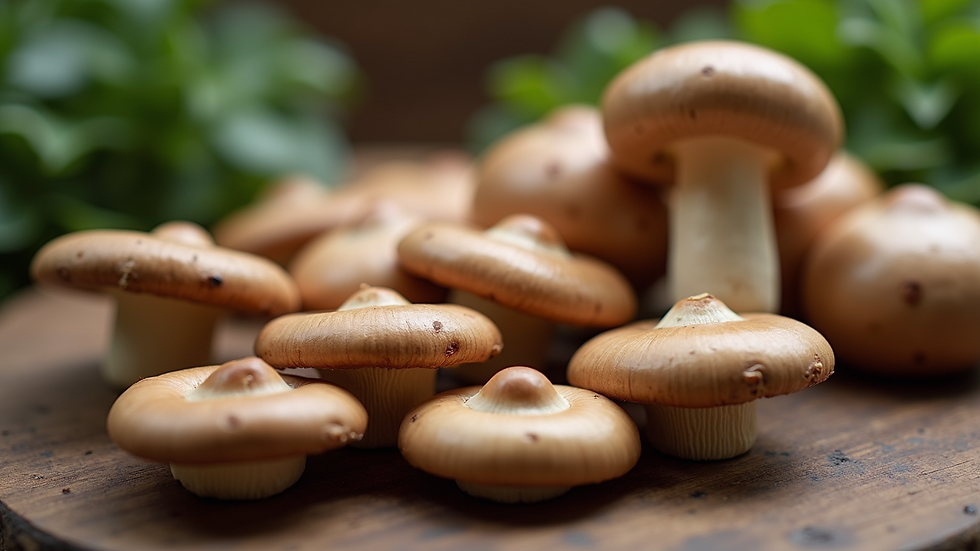How to Successfully Cultivate Morel Mushrooms
- Dave Holland
- Jul 15
- 4 min read
Morel mushrooms, with their unique flavor and culinary appeal, have intrigued mushroom hunters and chefs alike for centuries. Cultivating these delicate fungi can be an exciting endeavor, but it requires knowledge and patience. In this guide, we will explore the essential steps to grow morels successfully.
Steps to Grow Morels
Growing morel mushrooms is not as straightforward as cultivating other types of mushrooms. It involves a deep understanding of its habitat, environment, and life cycle. Here are the essential steps to guide you through the process:
Step 1: Choosing the Right Location
Morels thrive in specific habitats: they typically prefer well-drained soils that are rich in organic matter. Ideal locations include areas near dead or dying hardwood trees such as oaks, elms, and ashes.
When scouting for the right spot, consider these factors:
Soil Type: Loose, well-aerated soil is optimal for morels.
Sunlight: Morels prefer partial shade. Areas with filtered sunlight or dappled shade work best.
Proximity to Water: Ensure your location is near a water source, as mushrooms need moisture to grow.

Step 2: Preparing the Soil
Once you’ve chosen your location, it’s time to prepare the soil for planting. Start by removing any debris, rocks, or unwanted vegetation.
Next, enrich the soil to create a conducive environment for morels:
Compost: Adding aged compost will increase the organic content of the soil.
Lime: The soil pH for morels should be slightly alkaline, around 7.0 to 8.0.
Mulch: Adding a layer of mulch can help retain moisture and regulate soil temperature.
Keeping soil conditions in check is crucial; morels are sensitive to changes in their habitat.

Why Can't Morels Be Farmed?
Despite the interest in cultivating morels, many enthusiasts often wonder, "why can't morels be farmed?" The answer lies in the unique life cycle of these mushrooms. Morels form a symbiotic relationship with specific trees, which makes it challenging to cultivate them in a controlled environment.
Morels depend on a complex relationship with the mycorrhizal fungi in the soil. Each morel species may have different host tree preferences. This connection means that simply planting morels in a garden or using artificial substrates usually leads to failure. For successful cultivation, it is essential to work with the natural ecosystem rather than trying to force growth in unsuitable conditions.
Step 3: Planting Morel Spores or Spawn
After preparing your selected area and having the right conditions, it’s time to plant the morel spores or spawn. You can purchase morel spawn from reputable suppliers.
Follow these instructions for planting:
Timing: The best time to plant is in the spring when the soil temperature rises above 50°F (10°C).
Planting Depth: Dig small holes approximately 1-2 inches deep and place the spawn in the holes before covering them lightly with soil.
Spacing: Ensure there is sufficient space between each spawn to allow for growth, usually around 12 inches apart.
Step 4: Watering and Maintenance
Watering your morel planting area regularly is crucial for growth. Morels require consistent moisture but avoid overwatering that can lead to rot. When watering, make sure to:
Water early in the morning or late in the evening to prevent evaporation.
Use a gentle spray to avoid displacing the spores.
Regularly monitor your garden for weeds and pests. Weeds can compete with morels for nutrients and water, which can hinder their growth.

Step 5: Harvesting Morels
If conditions have been favorable, your morels will be ready to harvest typically in late spring. Harvesting morels requires care:
Use a sharp knife to cut the stem at ground level instead of pulling them out. This helps preserve the mycelium for future growth.
Harvest only the mature mushrooms. They should be firm and free of dark spots.
It’s essential to know that overharvesting can deplete your crop for next seasons, so practice sustainable harvesting techniques.
Additional Tips for Success
Patience is Key: Morel mushrooms have unpredictable growth patterns. It may take several seasons before you see significant yields.
Observe Nature: Spend time observing local foraging patterns, as nature can guide you on the best times to check your morel patches.
Join a Community: Engaging with local mushroom foraging clubs or online communities can provide support and valuable insights from experienced cultivators.
Growing morel mushrooms is not only fulfilling but can also yield delicious rewards for your culinary endeavors. If you are curious about how to grow morel mushrooms, consider exploring more resources to deepen your understanding of this fascinating process.
Embracing the Journey of Morel Mushroom Cultivation
As you embark on your journey to cultivate morel mushrooms, remember that this process is as much about enjoying nature as it is about the harvest. Appreciate the ecosystem you are nurturing and the knowledge you gain along the way. Whether you’re foraging in the wild or tending to your garden, the thrill of finding or growing these elusive mushrooms will make every effort worthwhile.
In your quest to grow morels, you might encounter challenges, but with dedication, patience, and the right approach, you will be well on your way to enjoying these sought-after fungi. Happy mushroom hunting and growing!




Comments